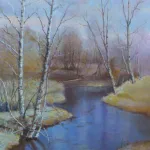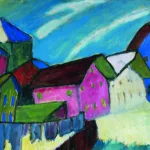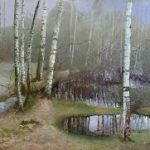When we think of Wassily Kandinsky, the pioneer of abstract art, we often picture his vibrant compositions of swirling colors and geometric forms. But behind every great artistic revolution, there are often lesser-known figures whose influence is profound. For Kandinsky, one such pivotal force was Gabriele Münter, a brilliant artist in her own right, whose unique vision significantly shaped his journey toward abstraction.
Münter and Kandinsky shared a passionate personal and artistic relationship, particularly during their time in Murnau, Bavaria, from 1908 to 1914. It was here, amidst the rustic charm and rich folk traditions, that Münter’s artistic inclinations truly began to leave their mark on Kandinsky.
One of Münter’s most significant contributions was her deep fascination with Bavarian folk art, particularly “Hinterglasmalerei” (reverse glass painting). She collected these traditional pieces and actively engaged with the technique. This simple, bold, and spiritually imbued art form, characterized by strong outlines, flat areas of intense color, and a lack of traditional perspective, profoundly resonated with Kandinsky. Münter’s enthusiasm and direct engagement with this style encouraged him to embrace a new artistic language, freeing him from academic constraints and pushing him towards simpler forms and more vibrant, non-naturalistic palettes.
Furthermore, Münter possessed a more intuitive and direct approach to painting. While Kandinsky sometimes grappled with theoretical complexities, Münter’s work was often spontaneous and emotionally charged, characterized by bold brushstrokes and a fearless use of color. This immediacy in her technique likely inspired Kandinsky to loosen his own style, moving away from illustrative representation towards a more expressive and uninhibited painterly freedom.
Her influence is also evident in the development of their shared theories on color and form. During their time together, both artists explored the emotional and spiritual power of colors and simplified forms. Münter’s early experiments with striking color contrasts and reduced figures directly contributed to the visual vocabulary that would become central to Kandinsky’s groundbreaking abstract works.
While their artistic journeys were ultimately distinct, it’s clear that Gabriele Münter was far more than just a companion; she was a catalyst. Her interest in folk art, her bold aesthetic, and her innovative use of color provided a crucial push, helping Kandinsky shed traditional shackles and solidify his revolutionary path towards pure abstraction.

“Color is a power which directly influences the soul.” — Wassily Kandinsky






